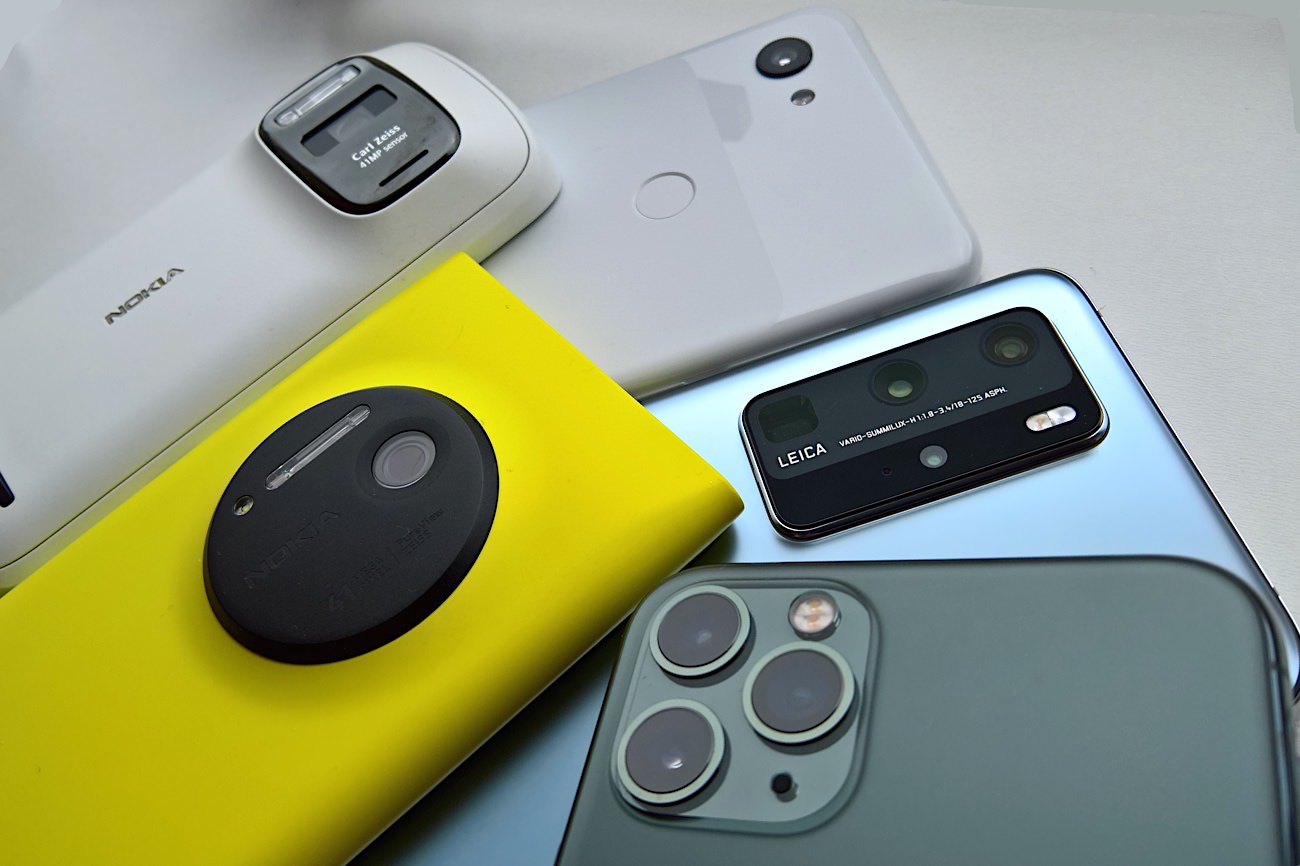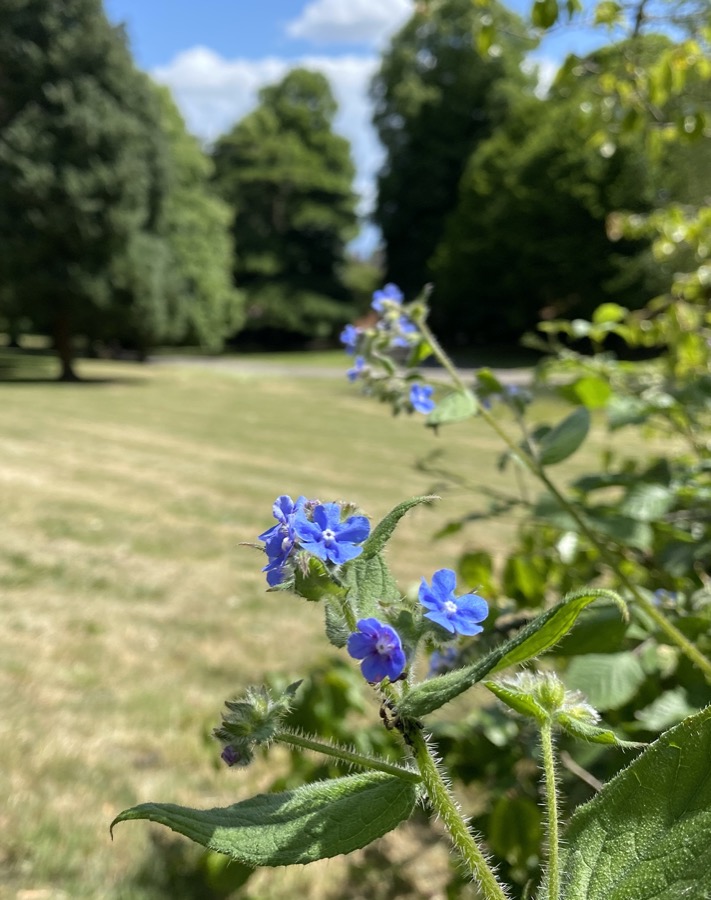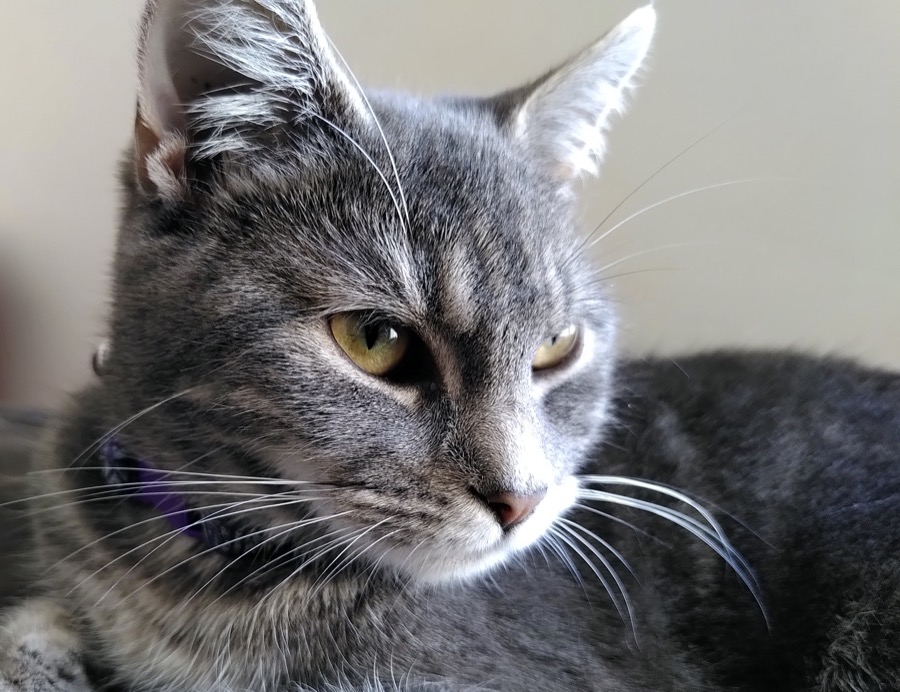
Now it might be that you're already ultra-confident in taking arty and effective photos of all subjects under all conditions, in which case good luck to you and well done. But if you're often left looking at flat and uninspiring photos and wondering what you're doing wrong then read on. Whether you have an old Lumia or Nokia 808 or Android flagship or iPhone 11 Pro, these tips will hopefully help.
1. Imagine
This sounds a bit nebulous, but it's vital to engage your brain before whipping out your phone to take a shot. (Unless it's something utterly amazing that's only going to last for a few seconds, of course!)

An early morning walk was blessed with sunshine and this fountain was crying out for some attention. Here with sun off to the left and my phone in 'Portrait' mode, to de-emphasise the green but boring backdrop...
As you walk along or attend an event or whatever, here are examples of the sorts of thing that should be running through your mind:
- the light is lovely right now, look at the colours on those flowers/that car/that water, how can I best capture the scene?
- how could I make the photo more dramatic and effective by repositioning myself? On the other side, at an angle, crouching down, etc?
- person X or Y is looking great, how can I snap them naturally without instigating a 'camera face'?
- what an interesting object, the light's not ideal, but how can I capture the most detail for enhancement later?
- could a multi-camera 'shallow depth of field' ("Portrait") shot help?
You get the idea. All the best photos, at least from a technical and artistic standpoint, come about because you've 'seen' the photo with your eyes and in your mind first and then wheeled out your phone and its camera to actually take it. It's about being aware, on any day out, at any event, at any location, of what might make a great snap and being ready to grab it, with your consciousness having already weighed up angles, light, colours, and distance, and knowing what do hit in the phone camera UI immediately.
Landscape or portrait orientation? It really is up to you. Unlike with video, where portrait is usually a no-no, with stills it completely depends on the subject. As you'll see from some of the examples of mine on this page! And hey, you'll often crop the shots slightly before sharing/archiving, so the full frame aspect ratio is often irrelevant. 30 years ago everything would have to resolve to 6" by 4" prints, but we're free to create in any aspect ratio and size these days.

Shot with the wide angle lens on my iPhone 11 Pro, looking straight up. Just a happy memory of an hour lying in a park on a hot day!
Multi-camera PS. here: having a wide angle or telephoto camera available here helps a bit in terms of the scope of what you might want to create, but do bear in mind that these lenses/sensors and focussing systems are always significantly less capable than the main camera on your phone, so use your feet first and resort to lens trickery last.
2. Light awareness
Now, back in the early days of smartphone cameras, light was everything. Unless the sun was out the photo would be dull and a dud. And if light was low then the result would be unusable. The advent of OIS (on the Lumia 920, in 2012) and multi-frame stacking and aligning of shorter exposures (on the Google Nexus 6P, in 2015) meant that low light could be handled easily on a phone camera, even when handheld, and these technologies changed the rules forever.
But handling of low light conditions doesn't mean that you don't have to think about light. Rather obviously, being photography, light is still rather crucial to the character of what you capture. Sunlight is still best, of course. Out and about shooting family and friends, shooting landscapes, shooting pets or statues or whatever you're into, colours will look more vibrant and everything will 'pop' off the screen or off a print. On a typical UK day out, this means being hyper aware of when the sun will appear from behind clouds(!) and taking your opportunity.

A little abstract, but I was fascinated by the ripples, reflections and optical distortions in the water in our paddling pool!
Snapping photos indoors or in the evening is now fine for static shots, since your phone's OIS or its camera software (whether Lumia/Android/iPhone) will work wonders keeping things crisp, but you'll still have issues, even in 2020, shooting pets or people - who tend to move, even slightly, during a long exposure (or set of exposures). Clever software can eliminate some of the resulting blur but it's obviously hamstrung. So you'll still need to ask people to pose and still have to hope for the best. (What's needed with people in low light is a proper flash, of course, but running a Xenon flash as on the Nokia 808 and Lumia 1020 has its own problems, since the very act of flooding a scene with that much light also flattens out ambient light and you lose some of the 'atmosphere'.) So keep your expectations for indoor and low light to a minimum. Just take as many photos as you can of each grouping or person or pet and - as I say - hope for the best and weed out the blurriest shots later on.
Light direction is also vital to be aware of. Avoid shooting into a light source (like the sun!) unless you want a blackened silhouette. Classic 'sun behind you' shots are all very well, but then any human subjects will be squinting, so I'd compromise and have the sun at about 45° behind you, keeping the scene lit without forcing people to squint.

The author, snapped on an iPhone 11 Pro in (telephoto-based) Portrait mode - I'm almost backlit, but the sunlight generally adds a nice gentleness to the scene...
3. Dirt and dust
Whichever phone you own, there's one common factor which can ruin every photo and video you take - fingerprints and other dirt or dust on the camera glass. A brief wipe on a soft cloth (or your shirt or trousers) is all that's usually needed - don't get too over-zealous about cleaning the glass, otherwise you might end up with micro-scratches. The main effect of dust, dirt or grease is to produce extra blur in the photo - in extreme cases, it can even stop focussing working properly - either way, you'll want a clean camera glass before you shoot. Any dust or finger grease on the glass, in the same way as small scratches, also plays havoc with any direct light sources, whether it's the sun or stage lights or even a bright lamp. The result is unsightly 'flare' on your photos, streaks of smeared light. If you've cleaned the glass and you're still getting flare then the cure is to again know where the strongest light sources are and try to avoid them shining on the camera glass of your device directly. If the light is off to one side and you've no option but to take the shot from your current position, then use one of your hands to shield the camera glass.

Perhaps a little clichéd, but I love outrageous natural bokeh - here with a moody rain shot, originally captioned with how frustrating it was to be stuck inside on a wet weekend away!
4. Subject and context
There isn't room here for a magic way to become an experienced photographer, of course, but a few pointers might help. Every photograph will have a subject - it's why you want to take that particular snap in the first place, whether it's a coastline or flower or person or pet. The secret is to present the subject in an interesting way. If every photograph just has the subject at its centre, with no context or other surroundings then your images will come across as dull and uninteresting to others.
Think about context then and consider shooting from different angles or heights:
- If shooting a landscape scene, try getting low down, to include a border of nearby ground at the bottom of the frame - or find a nearby tree or foliage or other feature to add interest at the edge of the frame.
- If shooting people, don't aim to get their whole bodies in, don't be afraid to get close up (and/or use telephoto optics or telephoto-based 'Portrait mode') - after all, it'll usually be faces you're interested in, not arms, legs and torsos.
- If shooting a flower, get down near its height, make sure your own shadow's not blocking the available light, be aware of what's in the background and make sure it's sufficiently neutral.
- If shooting pets, note that they don't know what a camera is, so don't get self-conscious, so you can get physically close and will pick up far more pet personality than just a wide shot of a 'cat' or 'dog'!
And in each case, be aware that the phone's Camera software is unlikely to know your artistic intent, so 'tap to focus' in the viewfinder (i.e. on the screen preview) and then capture the photo quickly afterwards before any scene auto-focus kicks back in!

Some truly tiny blue flowers given proper emphasis by getting down and close, tapping to focus and then allowing natural optical bokeh to do the rest...
5. Snap more than you need
Back in the 'old days', we had rolls of film with 12 or 24 exposures and that was our lot - every snap had to count. With digital photography on your smartphone and with truly (relatively) vast amounts of storage available for your JPG (or HEIC) photos, there's nothing stopping you going mad and taking more photos than you think you need. For example, you've been invited along to a garden party - it's easy enough to snap each guest 'that you haven't seen for ages' once and reckon that'll do, especially with modern phone cameras that nail the basic exposure every time. Back home, later, you'll find that half the shots have eyes closed, weird expressions or are motion-blurred. Take two or three of each scene or subject, just in case - you can then keep the one that came out the best and pretend those were the only ones you took!
Shooting pets is tricky because they never stay still or pose - a classic example of shoot lots and pick the best! Plus the closer the better, since you get wonderful detail!
6. Stabilise
Yes, all decent modern phone cameras have built in OIS (mounting the optics on tiny springs) or electronic gyro-stabilisation (taking the actual snap when the system detects the camera is moving the least). But there's only so much that the automatic systems can do in terms of counteracting lateral or angular movement. So you need to give them a hand...
In addition to not 'snatching' at the shutter button/icon on your phone, you should do everything you can to keep the device still relative to the environment. Taking a tripod with you is over the top(!), but stopping yourself wobbling around while taking a photo isn't always trivial - especially if you're in the middle of a field or on the beach and if it's cold or windy. Stand with your legs apart, braced against any breeze, and hold the camera phone in two hands, thumb and index or middle fingers on each side. In low light, if there's a wall or lamppost nearby, use that, pressing your body to it or, even better, resting the body of the camera phone on it or on one side of it.
7. Avoid digital zoom. Always. Really.
This sounds like advice from ten years ago and which can be safely ignored now, but it's just as applicable if you really want great photos that are pure and can be worked on later on (including cropping).
And yes, this being AAWP, I recognise that some would class the Nokia 808 and Lumia 1020 as using 'computational photography' and therefore 'digital zoom', but they really don't. These computational pioneers used smart cropping down to 1:1 on their sensors to achieve 2.5x lossless zoom. And that's fine. Then we have modern 2x and 3x telephoto lenses (i.e. Samsung Galaxy flagships, iPhone X and onwards) and these two are fine. Even the newer 'periscope' 5x telephoto lenses are fine. In each case as long as you stick to the zoom offered - the moment you use the Camera UI on the phone to go beyond the native optical zoom then you're into old fashioned 'digital zoom' territory. And, while algorithms have gotten better over the years, you can see the image degradation at the pixel level if you take, for example, a 2x telephoto up to 3x. Or a 5x periscope to 10x.

I'm honestly not sure what this is - I'm cropping into a photo I took of a flower in sunlight and I've lost the original. But I love the sci-fi look, almost a portal into another dimension!
For casual snaps, a little degradation in exchange for an extra zoom factor and better framing is probably OK, but as we're talking here about taking better photos then know your phone camera's optical zoom limit and stick to it religiously.
If you're shooting a scene and only really want the central part of it, move closer to the subject so that it fills the natural frame, if yuo can. And, if this isn't practical, for whatever reason, take the photo anyway at normal 1x or 2x (or whatever) zoom and then make a note to crop it later on the phone or on your desktop. Trust me, the final quality will be better than if you let the phone try to digitally zoom in real time.
8. Natural
It's all very well taking posed photos of people, but the problem is that they'll always look.... posed. In addition to getting the standard posed shots at events, use the fact that you have a phone-mounted camera to get up close with subjects, get them in the viewfinder, wait for the 'posed' expression and then distract them by making them laugh (or at the very least thinking about something else!) and then snap that shot (or, as mentioned above, several shots). 80% of the impromptu shots you take like this may be complete rubbish. The other 20% will be gems, possibly better than any of the 'pro' ('camera face') posed photos. Certainly, most of my favourite shots of family and friends were taken as 'natural' photos rather than in formal poses!

9. Get to know your Camera app's UI
This sounds rather obvious, but I'll bet you've never really explored all the functions and modes in the Camera application on your phone. What's the quickest way to switch aspect ratio from 4:3 to 16:9? Exactly how do you adjust exposure quickly and easily? Where is the Panorama mode? And so on. Practice all these at home before you head out with family or friends, so that they're second nature when your hands have to implement what your eyes and mind have just imagined (see tip 1 above!)

I spotted this amazing fiery sky the other day driving beside the Thames. It only lasted for a minute - good thing I remembered where 'Panorama' mode was! Note that 'panoramas' don't have to be crazy 270° sweeps and silly stretched images - use this mode whenever you have something that doesn't fit in a standard frame and when there's no foreground to take advantage of a wide angle lens!
10. Sort, curate, weed
By which I mean that it's vital to throw out failures and 'extra' photos through the year, i.e. sort and curate. Whenever you have a spare moment in a queue or on a rainy day, have a browse through OneDrive Photos or Google Photos or even just your phone's Camera roll. You don't have to delete anything you're not sure about, but for goodness sake delete the rubbish.
Why? Because:
- you'll save space. On the phone and in the cloud.
- you'll be wanting to find a specific photo in a couple of year's time and it'll be far, far easier with less photos to trawl through.
- when a friend or family member is browsing through your phone's photo gallery you naturally don't want them to see how bad a photographer you can (occasionally) be!
I'm as guilty as the next person here. In my various cloud storage vaults I have over 10,000 photos from the last 20 years of digital images. Gulp. I'm sure that can come down to a couple of thousand. Sort, curate, weed!

